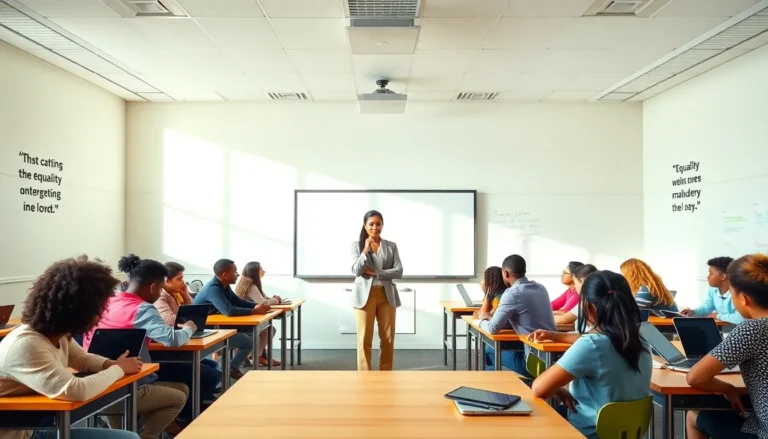Imagine stepping into a classroom where textbooks come to life and history lessons unfold right before your eyes. Welcome to the world of virtual reality education, where the traditional learning experience gets a high-tech makeover. It’s not just about donning funky goggles; it’s about diving into immersive environments that spark curiosity and foster engagement like never before.
Table of Contents
ToggleOverview of Virtual Reality Education
Virtual reality education merges immersive technology with traditional learning. It transforms how students engage with educational content.
What Is Virtual Reality Education?
Virtual reality education uses 3D environments to enhance learning experiences. These environments simulate real-world situations, making learning interactive. Students explore complex concepts with a hands-on approach, leading to deeper understanding. By employing VR, educators can create scenarios that aren’t feasible in a classroom setting. Various subjects, from science to history, utilize VR experiences to captivate students’ attention.
Brief History and Development
Virtual reality’s roots trace back to the 1960s, evolving significantly since then. Early concepts focused on simulations but lacked the sophistication of modern tools. The 1990s introduced more practical applications in gaming, which paved the way for educational uses. Advancements in technology in the 2000s led to more accessible and affordable VR hardware. Currently, institutions worldwide implement VR into curricula, harnessing its full potential. Both educators and institutions increasingly recognize the benefits, fueling further development in innovative educational tools.
Benefits of Virtual Reality Education
Virtual reality education offers numerous advantages, making learning more effective and enjoyable. Key benefits include improved learning experiences and heightened engagement.
Enhanced Learning Experiences
Immersive environments foster exploration and interaction. Students encounter life-like scenarios that enhance understanding of complex topics. For instance, a biology class can use VR to simulate human anatomy, allowing learners to visualize organs in 3D. Experiments in chemistry become safer and more feasible when conducted virtually. Different subjects gain depth through simulations, catering to various learning styles. Teachers utilize VR to bring abstract concepts to life, thus creating memorable lessons that resonate.
Increased Engagement and Motivation
Virtual reality captivates students’ attention, transforming the learning experience. Active participation in VR environments promotes enthusiasm for lessons. Statistics show that students engaged in VR show a 40% increase in retention rates. Gamified elements integrated into lessons further encourage interaction, inspiring students to take control of their learning journey. In addition, VR offers a break from standard classroom routines, keeping the curriculum fresh and stimulating. As learners connect more deeply with the material, motivation to explore new topics naturally follows.
Challenges in Virtual Reality Education
Virtual reality education presents several challenges that may hinder its effectiveness and widespread adoption. Understanding these obstacles is essential for addressing them.
Technical Limitations
Technical limitations frequently impact virtual reality education. High-quality VR systems demand significant processing power and graphics capabilities, which not all institutions possess. Moreover, software incompatibility can create issues for educators looking to implement cutting-edge tools. Frequent software updates also challenge educators, as they require consistent training for teachers and students alike. Furthermore, the initial setup cost for VR equipment can deter some schools from integrating technology into their curricula effectively. These factors combine to create disparities in access to viable VR education.
Accessibility Issues
Accessibility issues shape the landscape of virtual reality education. Not all students can use VR due to physical or cognitive disabilities. For instance, some individuals may experience motion sickness when using VR headsets. Financial constraints also prevent certain students from engaging with technology that enhances learning experiences. Limited access to necessary technology creates inequities among learners, widening the educational gap. Overall, addressing these accessibility issues becomes critical for making virtual reality education inclusive and equitable.
Applications of Virtual Reality Education
Virtual reality education finds significant applications across various educational levels and sectors.
In K-12 Schools
K-12 schools leverage virtual reality to enhance student engagement and understanding. Students can explore historical events firsthand, dive into ecosystems, or conduct virtual field trips. This immersive experience captivates students’ attention, leading to improved retention rates. Teachers utilize VR to visualize complex subjects, making challenging concepts accessible. Additionally, VR encourages collaborative learning through shared experiences, fostering teamwork and communication skills among students.
In Higher Education
Within higher education, virtual reality transforms traditional teaching methods. Medical students practice surgeries in simulated environments, reducing risks associated with real-life patients. Engineering programs enable students to experiment with designs in virtual labs, promoting hands-on learning. Art and design courses use VR to create and showcase work in immersive galleries. As a result, institutions find that students are more prepared for real-world challenges, thanks to these realistic simulations.
In Professional Training
Professional training programs increasingly incorporate virtual reality for skill development. Employees engage with VR simulations that mimic job scenarios, such as emergency response or customer service interactions. This approach allows participants to practice essential skills in a safe environment. Additionally, industries like healthcare and aviation use VR for cost-effective training solutions. Organizations recognize that realistic simulations heighten confidence and performance when employees face real situations.
Future Trends in Virtual Reality Education
Virtual reality education continues to evolve, driven by advancements in technology and innovative teaching strategies. Emerging technologies play a significant role in this transformation.
Emerging Technologies
Artificial intelligence integration enhances personalized learning experiences. Machine learning algorithms analyze student interactions, adapting content to individual learning styles. 5G connectivity enables seamless streaming of high-definition virtual environments, reducing latency and improving immersion. Additionally, haptic feedback devices offer tactile interactions, making simulations more realistic. Mixed reality platforms blend physical and digital elements, allowing students to manipulate virtual objects in real-time. Social VR platforms encourage collaboration across geographical boundaries, fostering global classroom interactions. These technologies collectively enhance engagement and provide richer educational experiences.
Predictions for the Next Decade
In the next decade, a substantial increase in VR adoption in education is expected. By 2030, nearly 80% of educational institutions could implement virtual reality in curricula. Enhanced affordability of VR systems will likely lead to wider accessibility for schools. Curriculum development is projected to focus on interdisciplinary approaches, integrating VR with subjects like science, history, and the arts. Remote learning environments may benefit significantly from VR, providing immersive experiences to students unable to attend in person. Gamification will likely dominate educational strategies, promoting motivation through immersive challenges. Virtual reality’s impact on learning outcomes will lead to a redefined educational landscape, emphasizing experience-based learning.
Virtual reality education is reshaping how students learn and engage with content. By creating immersive experiences that foster exploration and interaction, it enhances retention and understanding of complex subjects. Despite challenges such as access and affordability, the potential for VR to transform educational practices is undeniable. As technology continues to advance, the integration of virtual reality in classrooms is set to expand, promising a more interactive and inclusive learning environment. The future of education is bright with VR at the forefront, paving the way for innovative teaching methods that cater to diverse learning needs.



